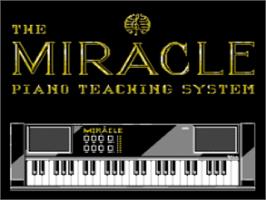A: The Piano Discovery System (PDS), reviewed in three different versions here on PEP, was developed by JumpMusic for Windows 3.1 (16-bit Windows) from the original Miracle Piano Teaching System, to which JumpMusic acquired the rights from The Software Toolworks. JumpMusic is long out of business, so neither the Miracle nor the Piano Discovery System are available commercially, except as aftermarket items.
Getting to Know You
During my get-acquainted session with the Miracle, I discovered the system is easy to set up! It takes up much less space than a regular piano and comes with a giant manual. The piano plugs into your NES and a power source and then you're ready to play.

The first thing you discover is that the Miracle can sound like anything from a church organ to a set of jungle drums. In fact, it can make over 128 sounds.

Piano Teaching Software
The software that comes with the system is your piano teacher -- complete with an estimated eight to twelve months worth of lessons (depending on how fast you learn and what your level of experience is). The lessons begin with the absolute basics -- get to know your keyboard, what fingers go where, and the names of the different keys. As time goes by the lessons grow more and more challenging -- you learn rhythm, how to read music, and, when I cheated and peeked ahead, lessons about things such as sharps, flats, musical notation, and accidentals. You even learn to play complicated pieces that at this point in time look like a strange foreign language. Each lesson starts with a description of what's to be learned, often accompanied by a demo of how it's supposed to sound.
Practice Makes Perfect
If you get bored with the normal lessons, you've got a couple of other practice alternatives in the 'Practice Room'. This section of the program lets you choose between playing one of the many pieces in the lessons (from 'Canon in D' to 'Hound Dog') accompanied by the Toolworks Orchestra (and they make even me sound good!), Practicing Rhythms, Practicing Notes, Having the Piano demonstrate the Piece, and then, of course Robo-Man and Shooting Gallery! Remember? This is an NES! Robo-Man is a robot who helps you develop rhythm by motoring along a conveyer belt and banging objects with his head when you hit a key on the keyboard. Shooting Gallery is an exercise to help you recognize notes. Ducks fly across a music staff, and you shoot them by hitting the corresponding note on the keyboard.
The Software Toolworks
Miracles Can Happen
What's a better deal? A year's worth of piano lessons or the Miracle? Check back in a year for the answer! I enjoy my Miracle piano lessons. I can pick the time and place. I can stop and start whenever I like. And most importantly, I can learn at my own pace. Drawbacks? You can't ask the Miracle questions. If you're stuck you must back up with your lessons or try to find the answers in the book. Plus, I missed the human touch and the motivation of having a mean old piano teacher staring over my shoulder. You have to really want to play to make this musical Miracle work.

I peeked ahead again so I know that if I practice, I'll be able to play 'La Bamba'. And of course, once I get that good I can use my Miracle piano with any sheet music I like. Hey, maybe I'll even present my first recital, sweaty palms and all, during the lunch hour at the offices -- now that would be a Miracle indeed.